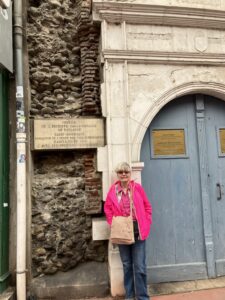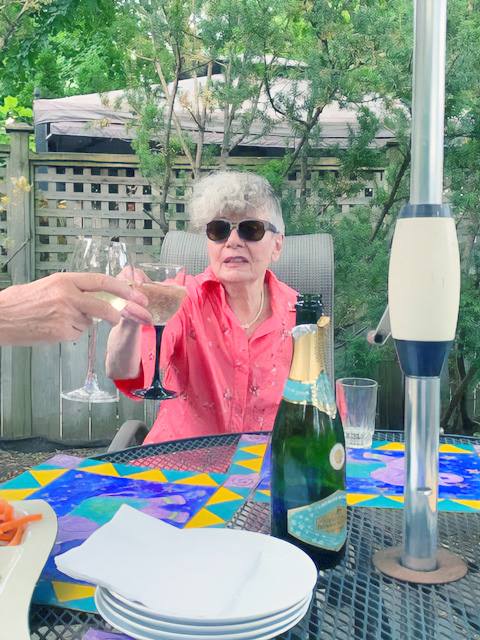
Welcome to my website—or, welcome back, if you’ve passed this way before.
On this page and beyond, you’ll find descriptions of my current writing projects, as well as a list of my previous work as a writer of fiction, drama, personal essays and creative non-fiction.
I also document recent “road trips” undertaken (many literally by car) to research fictional projects I’m working on that have historical or quasi-historical contexts. Travel to interesting places—research-related and otherwise— is an enjoyable experience in itself. So I hope that what I write on this website about the locations in North America and abroad that my partner Gene Allen and I have passed through, stopped off at, or stayed in for extensive periods of time, can convey the profound satisfaction of firsthand encounters with the past that not only inspire my work but continue to exist as enriching memories
Of course, during the shuttered years of the Covid pandemic (by no means over, but certainly no longer front of mind), the restrictions placed on travel and mingling in public places made armchair travelers out of many of us. As well, for me the imposition of involuntary isolation sharply focused on one writing project in particular. It is my play titled “O, Happy Solitude.”
O, Happy Solitude
“O, Happy Solitude” imagines the reclusive final years of playwright Maurine Dallas Watkins, who became famous in the 1920s for her play “Chicago.”. But by the 1950s, she had withdrawn from public life entirely. When she appeared at all, she kept her face completely obscured under thick veiling.
I’m certainly no recluse. Still, those several pandemic years of social isolation and being masked in public gave me some inkling of what it would feel like to retreat utterly from the world, like Maurine Watkins during the later decades of her life. In “O, Happy Solitude,” I speculate on what might happen, were this retired and retiring writer confronted by a young admirer, determined to unearth the reason behind the playwright’s self-imposed exile.
In August 2022, “O, Happy Solitude” was presented as an hour-long staged reading directed by dramaturge Bob White at the Meighen Forum in Stratford, in conjunction with the Festival Theatre’s production of Bob Fosse’s musical based on “Chicago.” (For which adaptation, Watkins strenuously refused to grant permission in her lifetime.)
The response to the Meighen Forum reading of “O, Happy Solitude” was very positive, and Bob and I felt the play could be expanded into a full-length drama. Over the following winter, as I did that work, I came to believe even more strongly that Maurine Watkins, with all her coverups, both literal and figurative, is a character both startlingly unique and at the same time highly recognizable—particularly in the era of celebrity culture in which we now live. For that reason, Bob and I have been hopeful that further development of the script, in collaboration with actors, will one day result in a full production.
Looking For Etta
Meanwhile, as part of a fictional quartet, I am continuing to work on a novel about another elusive female figure, the early 20th-century outlaw, Etta Place. (Or, if you prefer, Anne Marie Parker or Ethel Bishop, among her other aliases.) Reliable research about Etta is thin on the ground, which constitutes both an attraction and a benefit for a writer of fiction. There’s even some question—including in the mind of scriptwriter William Goldman, who brought Etta to widespread public attention in “Butch Cassidy and the Sundance Kid”—whether Etta Place, by any name, actually existed at all, except as a mythical amalgamation of a number of female outlaws, outriders and outliers in the fading days of the American Old West.
Personally, I’m still straddling the fence on that question, by giving both the scanty available information as well as wholesale speculation to Dana Jaeger, my fictional narrator of “Looking for Etta.” Dana, as a would-be documentary filmmaker in the late 1960s, gets hooked on Etta and remains hooked for much of her adult life.
Dana’s ceaseless fascination with the lady bandit has led me to explorations of my own into the culture of the American and Canadian West. And, since the easing of Covid restrictions, I not only continue to let my fingers do the walking through the pages of books and articles and endless Google sites, I’ve been able to travel in person to some of the historical locations pertinent to the elusive life and mysterious disappearance of Etta Place.
As William Goldman recognized in the 1960s, Etta belongs in the pantheon with the other heavily mythologized personalities of her milieu, including Butch and Sundance and the rest of the Wild Bunch. And, as my character Dana Jaeger speculates, Etta may also belong in the early Out West diaries of Owen Wister, the author of “The Virginian,” widely regarded as the first Western novel.
For more about my explorations of these and other aspects of the closing decades of the so-called “Wild” West, click this link:
Meanwhile, in another part of the fictional forest….
Readers of my previous work will know that, for me, animal characters occupy as prominent a place in the literary firmament as humans. Dogs in particular fascinate me, as they do many writers. Perhaps because, in their fifteen-thousand-year association with humans, dogs are surely the most beloved but also the most mistrusted of all our animal companions.
Previously, I explored that uneasy dichotomy between us and them in a non-fiction book, The Dog by the Cradle, the Serpent Beneath. The title is drawn from the compelling medieval story of a loyal dog misunderstood in life, but glorified after death. For more about that origin story, here is a portion of a talk I gave as part of Moses Znaimer’s IdeaCity series:
Master of the Dog
My current work in progress—a two-volume novel entitled Master of the Dog— begins in the same 13th-century milieu as the legend of the “holy greyhound” I explored in my non-fiction book. The first volume of the novel describes a world inhabited by draconian priests and devout pagans. A time when worship at the shrine of a slain greyhound would have been no more—and no less—controversial than the Church’s deadly crusades against fellow Christians, such as the Cathars and the Waldensians, who’d set up their own non-conforming sects.
In Master of the Dog, it’s a world that also includes a restless, ambitious silversmith’s son from London and a nameless dog he rescues from being skinned at a tannery. Together, they travel first to Montpellier, and later throughout much of the rest of France and western Europe in the company of a magnetic Spanish cleric named Dominic de Guzmán.
In order to enrich my sense of that era and that milieu, I recently visited the ancient city of Montpellier, which I’ve designated as the place where my fictional protagonist would first meet Dominic, real-life founder of the Order of Preachers, later known as the Dominicans.
I also traveled to Toulouse, in order to have a look at one of the historical locations in my fictional narrative: 7 Place de Parlement, the address of the house that Dominic’s friend and admirer, Peter Seila, offered to the charismatic priest, as his first monastery. The house itself has been rebuilt and repurposed numerous times over intervening centuries, Nowadays, the old door is nestled into the brick façade of the Institut Catholique de Toulouse, with a print shop conveniently next door and oblivious pedestrians hurrying by. But the old doorway remains, with a plaque commemorating Dominic’s arrival in the spring of 1215 with his “premiers compagnons.”
I’ve been living for years in imagination with these people. So it felt nothing short of astonishing to stand in the actual doorway at which the “real” Saint Dominic, had actually arrived more than 800 years before.

For more about the collision of past and present in France, click this link.
Master of the Dog, Volume Two
Volume Two of my novel Master of the Dog moves beyond the Middle Ages, to follow the lives of a number of artists, from the plague years in the British Channel Islands, to the studio of William Hogarth and his pug dog in 18th century London, to the estate near Fontainebleau where Rosa Bonheur, renowned in the latter half of the 19th century, turned out her masterly depictions of all manner of animals, including dogs.
The idea to follow the first volume of the novel with a cavalcade of canine artists originated in the Print and Drawing room at the Art Gallery of Ontario. Some years ago, I spent many happy hours there, among sketches and engravings of dogs done by artists as diverse as Albrecht Dürer, Eugène Delacroix Alex Colville, and of course, William Hogarth.
Here’s more about that research, in a presentation I did at the Art Gallery of Ontario in Toronto.
WATCH THE PRESENTATION HERE
BUY MY BOOKS AND PLAYS
You can purchase most of my works via my BOOKS AND PLAYS page.
BIO
Erika Ritter is a novelist, playwright, essayist and former CBC Radio host and broadcaster. She is the author of a novel, The Hidden Life of Humans, a non-fiction work on human-animal relationships, The Dog by the Cradle, The Serpent Beneath, and three collections of essays: Urban Scrawl, Ritter in Residence, and The Great Big Book of Guys: Alphabetical Encounters With Men. Ritter hopes soon to publish a quartet of novels, Talking to Time, one of which features playwright Maurine Watkins as a major character, as well as a two-volume novel, The Master of the Dog. Her produced stage plays include A Visitor From Charleston, The Splits, and Automatic Pilot. A new short play “O, Happy Solitude,” also about Maurine Watkins, had a public reading at the Stratford Festival in August 2022 and has since been extended to a full-length work.
REVIEWS
About THE DOG BY THE CRADLE, THE SERPENT BENEATH…
“Ritter’s new book, The Dog By the Cradle, the Serpent Beneath, is a far-reaching exploration of the paradox underlying our relationships with animals. Her devotion to gaining insight into that tortured relationship is quite amazing.” – THE GLOBE AND MAIL
“….a passionate, thought-provoking addition to the canon.” – QUILL AND QUIRE
“(Ritter’s) informal exploration—weighty and whimsical—of the contradictory way we treat animals… is well-researched and thought-provoking…” – THE MONTREAL GAZETTE
About THE GREAT BIG BOOK OF GUYS: ALPHABETICAL ENCOUNTERS WITH MEN…
“Even though no two stories are alike….we remain riveted, unable to look away from whatever Ritter is entreating us to see. Part memoir, part inspirational handbook for the cynical, part divine comedy, The Great Book of Guys is marvellously entertaining from start to stop. Comparatively few titles can make the same claim.” – KIM HUGHES
